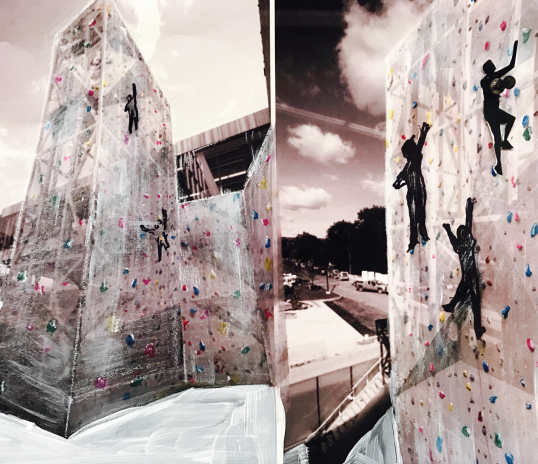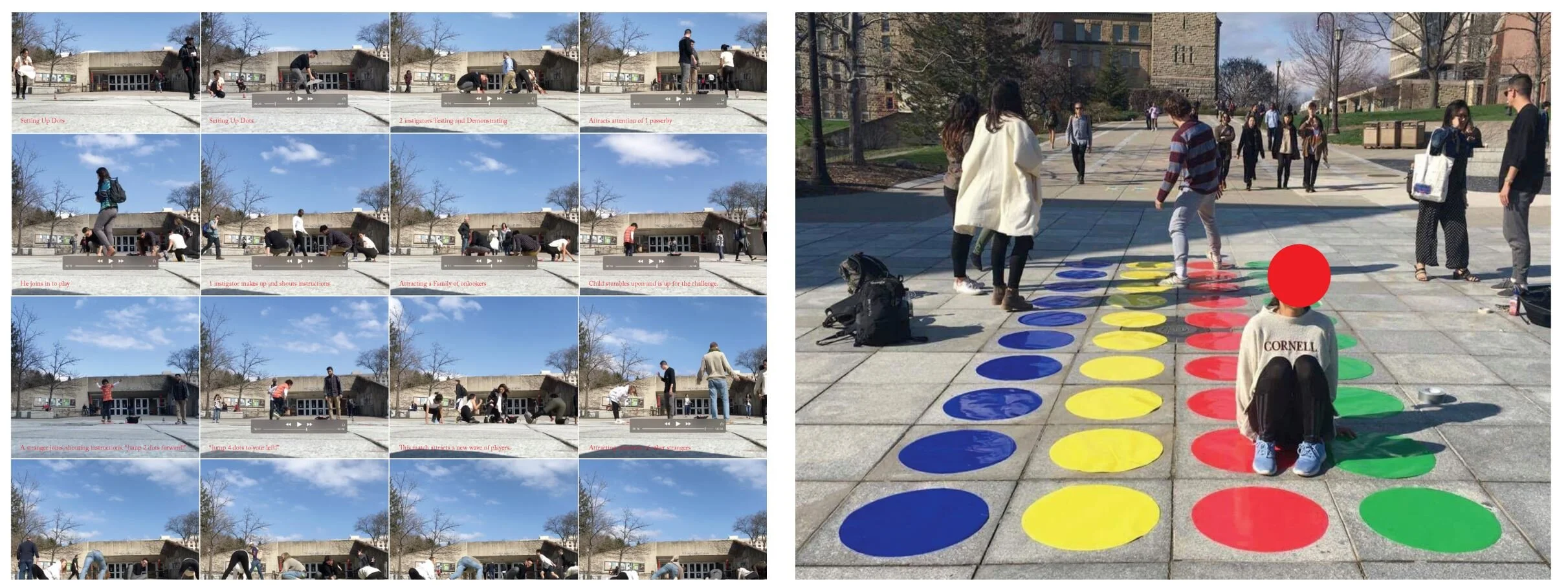
Activating Playces
on Campus
Activating Playces
Challenge
Build community by creating moments of play and serendipity at a campus-wide scale.
Outcome
A series of activations, provocations and playbook on how to activate community through playful interventions.
Opportunity
How might we activate places through play to create a sense of belonging and connection?
Role
Conducted user research, designed experiments and implemented activations. This was independent and self-initiated work conducted during my final year in architecture school.
1. Understand
In order to understand the campus culture and opportunities, I hosted a design charette inviting students across campus to map out their ideas on how to create a closer community.
The ideas revealed common themes around:
Surprise
Spontaneity
Play
Humor
Students often identified places that were central, shared and had an existing flow of students and faculty.
2. Design + Activate
Based on these insights around play and potential locations, I identified campus locations that had an existing flow of people, but may be underutilized or overlooked. Based on the constraints of the site, I designed interventions that would be easily scalable. Sites of experiments included: Ho Plaza, Sibley Dome, Rand Hall Staircase, Schwarzman Bus Stop Wall and Plaza.
I conducted 5 activations:
Sibley Court
Rand Ballpit
Blowing up the Dome
Plaza Twister
Yoga + Moments Wall
Plaza Twister
Slope Slide
3. Imagine + Provoke
After the activations, I documented each into a playbook that detailed the purpose, materials, and set-up so that it could be easily recreated. I also observed that the activations themselves helped shape new perceptions and behaviors that inspired other events and activities in the previously overlooked space. Through the power of sketches, I drew out further imaginations to provoke the Cornell community to dream bigger on how we might reimagine our campus.
Activated Playces
Sibley Court
Rand Ballpit
Blowing up the Dome
Plaza Twister
Yoga + Moments Wall
1. Sibley Court
Location: Identified a hallway location that was empty, but located near the elevators, bathrooms and studios and always drew a lot of foot traffic.
Activation: A ballcourt and ping-pong tables that leverages the existing columns to use as a frame.
Materials: 4 saw horses, 2 plywood sheets, 1 large bouncy ball, 1 roll of red tape, 3 meters of netting, and 3 ping pong balls.
Outcomes: 300 people participated over a week long period without prompting by playing ping-pong and a large-scale version of ping pong without hands as racquets.
Learnings: Identify locations with existing heavy traffic that are thoroughfares between popular destinations. Design a way to invite people through signage and games people are already familiar with. Create surprise by designing at various scales, and a temporary duration.


2. Rand Ballpit
Location: Identified the underside of a staircase located next to our Shop and entrance to the Library. It used to be the location of a phone booth for students to call home, but now sat empty. The area draws foot traffic from those entering the Library and Shop at all hours.
Activation: A Balloon Ballpit that leverages the volume of the underside of the stair.
Materials: 200 white balloons, air, colored lights, foam blocks.
Outcomes: 30 people engaged over one morning.
Learnings: Identify location that is part of circulation and next to popular destinations. Physically and spontaneously invite people to engage and leverage people attracting other people.
3. Blowing Up the Dome
Challenge: Within the College of Architecture, Art, and Planning, each department is siloed from one another and often stick to their department-owned spaces. "None of the departments interact with one another which is an issue, and the college is also incredibly isolated from the other six colleges." -AAP Student
Opportunity: How might we create connections between the different departments (architecture, art and planning)?
Location: Identified the Sibley Dome and mezzanine, a neutral space that isn’t owned by any particular department and is the current home of the IT desk and previous home to the Library collection. Today it draws people in who need to rent equipment or need IT support from all departments, however it is empty in creating meaningful connections between the different stakeholders that visit.
Activation: An interactive installation that invited students and faculty from each department to participate. Prior to the event, paper invitations with a balloon and string were distributed by organizers from architecture, art and planning. Depending on your department, you were handed a balloon with a specific colored string. The rules were that you had to blow up your balloon, and then tie it to a balloon with a different string color (from a different department). Participants worked towards a collective installation, and had spontaneous conversations and connections. People who had shared a space and college for up to 5 years together were able to meet for the first time.
Materials: 400 balloons, 3 colors of string, 3 tanks of helium, 230 paper invitations
Outcomes: 300 people participated over a two hour period through paper invitations with one balloon and piece of string. Conversations between students and faculty from different departments arose as they worked with a specific ruleset to collectively to build an installation.
Learnings: Identify a location that carries a neautral meaning for all communities involved. Design a personalized way to invite people through individual invitations from their friends. Create clear rules on how to play to equalize how different communities participate. Prompt behavior by setting breadcrumbs and starting the initial installation. Make it a surprise by leaving no trace of the installation after event is over.
4. Plaza Twister
Location: Identified Ho Plaza, the intersection between campus and Collegetown right across from the Campus Store and Student Union. Hundreds of students pass through Ho Plaza to attend class or return home.
Activation: Plaza Twister, a large scale game of twister that leverages the centerpoint of the Plaza and the size of it’s tiles. Roles: players, sign spinner and reader. Rules:
Materials: 50 17”x17” paper dots, 1 roll of duct tape
Outcomes: 25 people played over a one hour period. From students and faculty and their families.
Learnings: Identify locations with existing heavy traffic that are thoroughfares between popular destinations. Have an instigator on-site to invite people to play. Create specific rules and structure on how to play.
5. Yoga + Moments Wall
Location: Schwarzman Bus Stop and Plaza behind. This space is located right at the entrance to Collegetown across from the revered Collegetown Bagels. Hundreds of students pass by on their way home and many students wait in front of the wall for their bus. The Plaza behind the wall is never utilized.
Activation: Yoga and Moments Wall. To bring awareness to the centrality and emptiness of the plaza, I hosted a yoga class. To provide function to the wall and leverage the time spent by students waiting, I designed an installation that asked passerby and those waiting to reflect on their last year and share a favorite Cornell memories of theirs.
Materials: Yoga mats, paint samples, twine and tape.
Outcomes: 50 participants and memories over the course of a day. A year later, the plaza was transformed to a public space.
Learnings: Identify locations that are underlooked, but are the backdrop to existing foot traffic. Activate through specific temporary programs that are scheduled and unscheduled to create surprise.
Insights to Imagine
I continued to identify sites that shared similar qualities: central location, high foot traffic but underutilized, overlooked and in need of reimagination. Each activation incorporated principles of play: how to invite people, the roles they played, the ruleset of engagement and how to create surprise and delight.
Through paints and pen, I sketched a variety of activations that leveraged the power of play and could continue across campus. The goal was to paint an imagined future in order to spark imagination in others and shape new perceptions and behaviors.

























